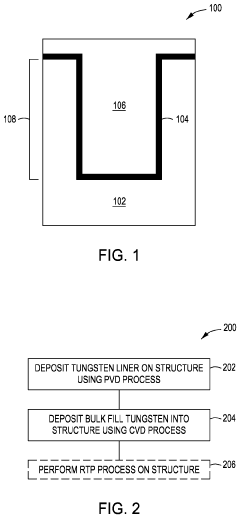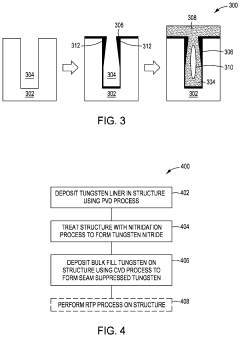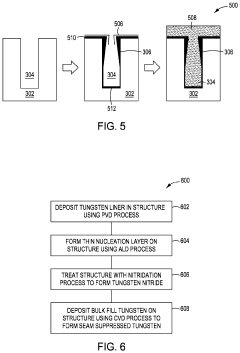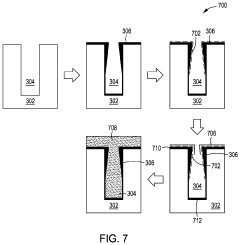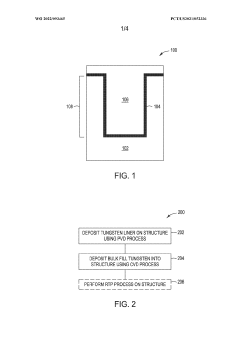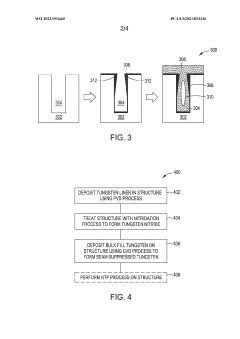Tungsten Challenges In Modern Engineering Solutions
Tungsten Tech Evolution
Tungsten has played a pivotal role in engineering solutions since its discovery in the late 18th century. The evolution of tungsten technology can be traced through several key stages, each marked by significant advancements and breakthroughs.
In the early 20th century, the development of tungsten filaments for incandescent light bulbs marked the first major application of this metal. This innovation revolutionized lighting technology and paved the way for further exploration of tungsten's unique properties.
The 1920s and 1930s saw the emergence of tungsten carbide, a composite material that combines tungsten with carbon. This development led to a new era in cutting tool technology, significantly improving the efficiency and durability of machining processes in various industries.
During World War II, tungsten's importance in military applications became evident. Its use in armor-piercing ammunition and high-temperature alloys for aircraft engines demonstrated the metal's strategic value in defense technologies.
The post-war period witnessed the expansion of tungsten applications in the growing electronics industry. Its high melting point and excellent electrical conductivity made it ideal for use in vacuum tubes and later in integrated circuits.
In the 1960s and 1970s, advancements in powder metallurgy techniques enabled the production of more complex tungsten alloys and composites. This led to improved performance in high-temperature applications, such as rocket nozzles and turbine blades.
The late 20th century saw the integration of tungsten in thin film technology, particularly in the semiconductor industry. Tungsten's low resistivity and compatibility with silicon made it an essential material for interconnects and diffusion barriers in microchips.
Recent decades have focused on addressing the challenges of tungsten's brittleness and high density. Research into nanostructured tungsten and tungsten-based composites has aimed to improve ductility while maintaining its exceptional high-temperature properties.
The 21st century has brought renewed interest in tungsten for nuclear fusion applications. Its high melting point and resistance to plasma erosion make it a promising material for fusion reactor components, driving ongoing research and development efforts.
Throughout its technological evolution, tungsten has consistently demonstrated its versatility and importance in engineering solutions. From lighting to aerospace, electronics to energy, the journey of tungsten technology reflects the broader progress of materials science and engineering over the past century.
Market Demand Analysis
The market demand for tungsten in modern engineering solutions has been steadily increasing due to its unique properties and versatile applications. Tungsten's exceptional strength, high melting point, and excellent thermal and electrical conductivity make it indispensable in various industries, driving the growth of its market.
In the aerospace and defense sectors, tungsten alloys are crucial for manufacturing components that require high temperature resistance and durability. The growing investments in space exploration and military modernization programs have significantly boosted the demand for tungsten-based materials. Additionally, the automotive industry's shift towards more efficient and lightweight vehicles has led to increased use of tungsten in engine components and exhaust systems.
The electronics industry represents another major market for tungsten, particularly in the production of integrated circuits and semiconductors. As the global demand for electronic devices continues to rise, so does the need for tungsten in this sector. The ongoing miniaturization trend in electronics further emphasizes the importance of tungsten's properties in creating smaller, more efficient components.
In the energy sector, tungsten plays a vital role in both traditional and renewable energy technologies. Its use in drilling equipment for oil and gas exploration remains significant, while its applications in solar panels and wind turbines are expanding. The global push towards clean energy solutions is expected to drive further demand for tungsten in these applications.
The medical industry has also emerged as a growing market for tungsten, particularly in radiation shielding and medical imaging equipment. The increasing prevalence of cancer treatments and diagnostic procedures utilizing radiation has led to a higher demand for tungsten-based shielding materials.
Market analysis indicates that the global tungsten market is projected to grow at a compound annual growth rate (CAGR) of around 4-5% over the next five years. This growth is primarily attributed to the expanding applications in emerging technologies and the recovery of traditional industries post-pandemic.
However, the tungsten market faces challenges related to supply chain disruptions and geopolitical tensions affecting major producing countries. China, the world's largest tungsten producer, has implemented export restrictions, leading to supply uncertainties and price volatility. This situation has prompted many countries to seek alternative sources and invest in recycling technologies to reduce dependence on primary tungsten production.
The increasing focus on sustainable practices and circular economy principles is also shaping the tungsten market. There is a growing emphasis on developing efficient recycling methods for tungsten-containing products, which could potentially alleviate some of the supply concerns while addressing environmental considerations.
Current Challenges
Tungsten, a metal with exceptional properties, faces several significant challenges in modern engineering applications. One of the primary issues is its high melting point, which, while advantageous in some scenarios, poses difficulties in manufacturing and processing. The extreme temperatures required for melting and shaping tungsten necessitate specialized equipment and techniques, increasing production costs and limiting its widespread use.
Another challenge lies in tungsten's brittleness at room temperature. This characteristic makes it prone to cracking and fracturing under stress, limiting its application in certain structural components. Engineers must carefully consider this property when designing tungsten-based parts, often requiring additional reinforcement or alternative materials for specific applications.
The density of tungsten, while beneficial in some applications, presents challenges in others. Its high weight-to-volume ratio can be problematic in aerospace and automotive industries where weight reduction is crucial for fuel efficiency and performance. This limitation often forces engineers to seek alternative materials or develop composite solutions to balance the benefits of tungsten with the need for lighter structures.
Corrosion resistance is another area of concern for tungsten in engineering applications. Although it generally exhibits good resistance to many chemicals, tungsten can be susceptible to oxidation at elevated temperatures. This vulnerability necessitates protective coatings or controlled environments in high-temperature applications, adding complexity and cost to engineering solutions.
The scarcity and geopolitical factors associated with tungsten production present additional challenges. The limited global supply and concentration of tungsten resources in specific regions can lead to supply chain vulnerabilities and price volatility. This uncertainty complicates long-term planning and investment in tungsten-based technologies.
Environmental concerns also pose challenges in tungsten utilization. The mining and processing of tungsten ore can have significant environmental impacts, including habitat destruction and water pollution. As sustainability becomes increasingly important in engineering practices, finding more environmentally friendly methods of tungsten extraction and processing is crucial.
Lastly, the recyclability of tungsten presents both a challenge and an opportunity. While tungsten can be recycled, the process is often complex and energy-intensive. Developing more efficient recycling technologies and establishing effective collection systems for tungsten-containing products are essential for improving the sustainability of tungsten use in engineering applications.
Existing Solutions
01 Tungsten deposition methods
Various methods for depositing tungsten on substrates, including chemical vapor deposition (CVD) and atomic layer deposition (ALD). These techniques are used to create thin films of tungsten for applications in semiconductor manufacturing and other industries.- Tungsten deposition methods: Various methods for depositing tungsten on substrates, including chemical vapor deposition (CVD) and atomic layer deposition (ALD). These techniques are used to create thin films of tungsten for applications in semiconductor manufacturing and other industries.
- Tungsten etching processes: Techniques for selectively removing tungsten from surfaces, often used in semiconductor fabrication. These processes may involve chemical etching, plasma etching, or other methods to pattern tungsten layers or remove unwanted tungsten deposits.
- Tungsten-based alloys and composites: Development of materials that incorporate tungsten with other elements to create alloys or composites with enhanced properties. These materials may offer improved strength, heat resistance, or other desirable characteristics for specific applications.
- Tungsten in electronic components: Use of tungsten in various electronic components and devices, such as interconnects, electrodes, and heat sinks. Tungsten's high melting point and good electrical conductivity make it valuable in these applications.
- Tungsten powder production and processing: Methods for producing and processing tungsten powder, including techniques for controlling particle size, shape, and purity. These processes are important for creating tungsten-based materials and components for various industrial applications.
02 Tungsten etching processes
Techniques for selectively removing tungsten from surfaces, often used in the fabrication of integrated circuits. These processes may involve chemical etching, plasma etching, or a combination of methods to achieve precise patterning of tungsten layers.Expand Specific Solutions03 Tungsten alloys and composites
Development of tungsten-based alloys and composite materials for improved performance in various applications. These materials may combine tungsten with other elements or compounds to enhance properties such as strength, conductivity, or wear resistance.Expand Specific Solutions04 Tungsten in electronic components
Applications of tungsten in electronic devices, including its use in interconnects, electrodes, and other conductive structures. This may involve specific processing techniques to integrate tungsten into complex electronic architectures.Expand Specific Solutions05 Tungsten powder production
Methods for manufacturing tungsten powder with specific particle sizes and characteristics. These processes are crucial for producing high-quality tungsten materials for various industrial applications, including additive manufacturing and powder metallurgy.Expand Specific Solutions
Key Industry Players
The tungsten industry is currently in a mature phase, with a global market size expected to reach $5.7 billion by 2027. The technological maturity of tungsten applications varies across sectors, from well-established uses in traditional industries to emerging applications in advanced engineering. Companies like Applied Materials, Inc., Cabot Microelectronics Corporation, and Xiamen Tungsten Co., Ltd. are at the forefront of developing innovative tungsten-based solutions for semiconductor manufacturing and electronic materials. Research institutions such as Central South University and Jiangxi University of Science & Technology are contributing to advancements in tungsten processing and applications. The competitive landscape is characterized by a mix of established players and new entrants, with a focus on developing high-performance tungsten materials for cutting-edge engineering applications in aerospace, electronics, and energy sectors.
Xiamen Tungsten Co., Ltd.
Chongyi Zhangyuan Tungsten Co., Ltd.
Core Innovations
- The proposed method involves a physical vapor deposition of a tungsten liner, followed by an atomic layer deposition nucleation layer and a chemical vapor deposition bulk fill process, with a nitridation step and optional rapid thermal processing to reduce internal stresses and lower resistivity, using argon or krypton as ambient gases and optimizing temperature, pressure, and nitridation conditions.
- The method involves depositing a tungsten liner using physical vapor deposition, followed by a nitridation process and bulk fill tungsten using chemical vapor deposition, with optional rapid thermal processing to reduce internal stresses and lower resistivity, while eliminating boron to prevent adhesion issues.
Supply Chain Dynamics
The supply chain dynamics for tungsten in modern engineering solutions are complex and multifaceted, influenced by various factors including geopolitical tensions, market fluctuations, and environmental concerns. Tungsten, a critical raw material for many high-tech applications, faces significant challenges in its supply chain due to its limited geographical distribution and the concentration of production in a few countries, primarily China.
The global tungsten market is characterized by a high degree of volatility, with prices subject to rapid changes based on supply and demand imbalances. This volatility is exacerbated by the fact that tungsten is often a by-product of other mining operations, making its production dependent on the economics of other minerals. As a result, manufacturers relying on tungsten for their engineering solutions must navigate uncertain supply conditions and price fluctuations.
Geopolitical factors play a crucial role in shaping the tungsten supply chain. China's dominance in tungsten production has led to concerns about supply security among Western nations, prompting efforts to diversify sources and develop alternative supply chains. This has resulted in increased exploration and mining activities in countries such as Vietnam, Russia, and Bolivia, albeit with varying degrees of success and sustainability.
Environmental and social considerations are increasingly impacting the tungsten supply chain. Stricter regulations on mining practices, particularly in developed countries, have led to the closure of some tungsten mines and increased production costs. Additionally, growing awareness of conflict minerals has necessitated greater transparency and traceability in the tungsten supply chain, adding complexity to procurement processes for engineering firms.
Recycling and circular economy initiatives are emerging as important factors in the tungsten supply chain. The high value of tungsten and its recyclability have encouraged the development of advanced recycling technologies and the establishment of secondary supply chains. This trend is expected to grow, potentially alleviating some of the supply pressures and reducing dependence on primary mining operations.
The COVID-19 pandemic has further highlighted the vulnerabilities in the tungsten supply chain, exposing the risks of over-reliance on single sources and the need for more resilient supply networks. As a result, many companies are reevaluating their supply chain strategies, focusing on diversification, stockpiling, and the development of local or regional supply alternatives.
In response to these challenges, innovative solutions are emerging in the tungsten supply chain. These include the development of new extraction technologies to make previously uneconomical deposits viable, the use of blockchain technology for improved traceability, and the exploration of tungsten substitutes in certain applications. However, the unique properties of tungsten make it irreplaceable in many critical engineering applications, underscoring the ongoing importance of addressing supply chain challenges.
Environmental Impact
The environmental impact of tungsten extraction and processing is a significant concern in modern engineering solutions. Tungsten mining operations often involve open-pit mining, which can lead to extensive land disturbance and habitat destruction. The extraction process requires substantial energy inputs, contributing to increased carbon emissions and climate change concerns.
Water pollution is another critical issue associated with tungsten mining and processing. Acid mine drainage, a common byproduct of tungsten extraction, can contaminate nearby water sources with heavy metals and other toxic substances. This pollution can have long-lasting effects on aquatic ecosystems and potentially impact human health in surrounding communities.
The refining process of tungsten ore also generates considerable waste, including tailings and slag. These byproducts often contain hazardous materials that require careful management and disposal to prevent environmental contamination. Improper handling of these wastes can lead to soil degradation and groundwater pollution, further exacerbating the environmental impact.
Air quality is another area of concern in tungsten production. The smelting and refining processes emit particulate matter, sulfur dioxide, and other air pollutants. These emissions can contribute to local air pollution problems and have adverse effects on human health and the environment.
Efforts to mitigate the environmental impact of tungsten production have led to the development of more sustainable mining practices and improved processing technologies. Recycling of tungsten from scrap materials has gained importance as a means to reduce the demand for primary tungsten extraction. This approach not only conserves natural resources but also helps minimize the environmental footprint of tungsten production.
The implementation of stricter environmental regulations and standards in many countries has pushed the tungsten industry to adopt cleaner production methods. These include the use of more efficient extraction techniques, improved waste management practices, and the integration of renewable energy sources in processing operations.
As the demand for tungsten continues to grow in various engineering applications, balancing economic needs with environmental protection remains a crucial challenge. The development of innovative, eco-friendly technologies for tungsten extraction and processing is essential for ensuring the long-term sustainability of this important resource in modern engineering solutions.
